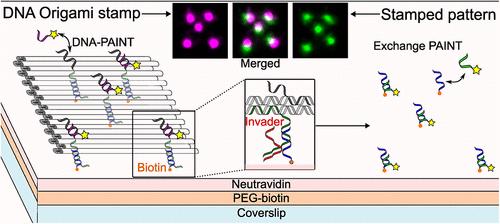利用DNA折纸技术在纳米尺度上精确冲压生物分子模式
IF 16
1区 材料科学
Q1 CHEMISTRY, MULTIDISCIPLINARY
引用次数: 0
摘要
理解配体模式在生物过程中的重要性需要精确控制分子定位和间距。虽然DNA折纸结构在生物分子排列方面提供了纳米级的精度,但它们的生物应用受到与结构稳定性、可扩展性和表面积相关的挑战的限制。在这里,我们提出了一种简单快速的DNA折纸冲压技术,用于将纳米级寡核苷酸图案转移到表面上,使用DNA- paint超分辨率显微镜进行可视化,以定量评估不同冲压类型的冲压效率和精度。与传统的自上而下的方法需要专门的设备不同,我们的技术提供了一个可访问的,自组装的表面图案化平台,通过可修改的图案转移寡核苷酸在各种底物上具有多功能性。我们在单分子分辨率上展示了可靠、高效和精确的模式转移,为研究距离依赖的生物过程提供了机会,包括受体激活、多价结合和跨更广泛的空间尺度和不同的检测技术的酶级联。钝化表面的使用限制了与非图案化区域的非特异性相互作用,并能够控制生物靶标与图案化生物分子之间的相互作用。我们的方法通过将DNA纳米技术与单分子成像技术相结合,扩大了成本效益分析方法的使用范围,并有可能实现多路检测和实时测量,从而推进了表面图像化。本文章由计算机程序翻译,如有差异,请以英文原文为准。

Nanoscale Precise Stamping of Biomolecule Patterns Using DNA Origami
Understanding the importance of ligand patterning in biological processes requires precise control over molecular positioning and spacing. While DNA origami structures offer nanoscale precision in biomolecule arrangement, their biological applications are limited by challenges related to their structural stability, scalability, and surface area. Here, we present a straightforward and rapid DNA origami stamping technique for transferring nanoscale oligonucleotide patterns onto surfaces, visualized using DNA-PAINT super-resolution microscopy to quantitatively assess the stamping efficiency and precision across different stamp types. Unlike traditional top-down methods that require specialized equipment, our technique provides an accessible, self-assembled platform for surface patterning, with versatility across various substrates via modifiable pattern-transfer oligonucleotides. We demonstrate reliable, efficient, and precise pattern transfer at single-molecule resolution, opening opportunities to study distance-dependent biological processes, including receptor activation, multivalent binding, and enzymatic cascades across broader spatial scales and different detection techniques. The use of the passivated surface limits nonspecific interactions with unpatterned areas and enables control over the interaction between the biological target and the patterned biomolecules. Our method advances surface patterning by combining DNA nanotechnology with single-molecule imaging techniques, expanding access to cost-effective analytical approaches and potentially enabling multiplexed detection and live measurements.
求助全文
通过发布文献求助,成功后即可免费获取论文全文。
去求助
来源期刊

ACS Nano
工程技术-材料科学:综合
CiteScore
26.00
自引率
4.10%
发文量
1627
审稿时长
1.7 months
期刊介绍:
ACS Nano, published monthly, serves as an international forum for comprehensive articles on nanoscience and nanotechnology research at the intersections of chemistry, biology, materials science, physics, and engineering. The journal fosters communication among scientists in these communities, facilitating collaboration, new research opportunities, and advancements through discoveries. ACS Nano covers synthesis, assembly, characterization, theory, and simulation of nanostructures, nanobiotechnology, nanofabrication, methods and tools for nanoscience and nanotechnology, and self- and directed-assembly. Alongside original research articles, it offers thorough reviews, perspectives on cutting-edge research, and discussions envisioning the future of nanoscience and nanotechnology.
 求助内容:
求助内容: 应助结果提醒方式:
应助结果提醒方式:


